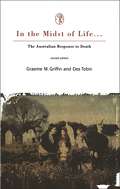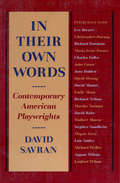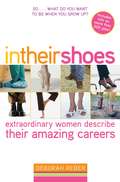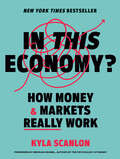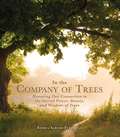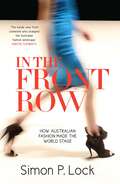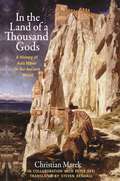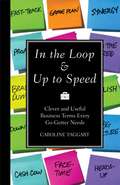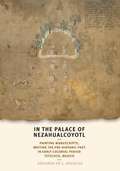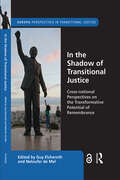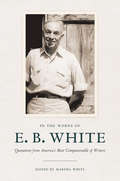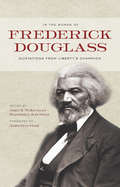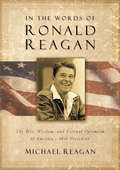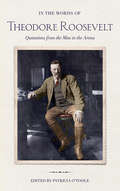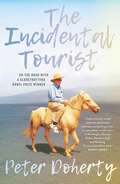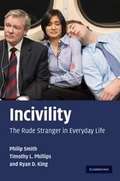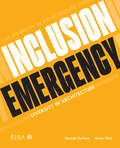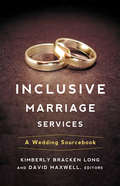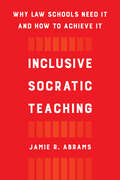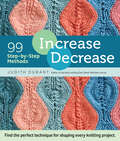- Table View
- List View
In The Midst Of Life
by Des Tobin Graeme M GriffinThis is a thoroughly useful, authoritative and compassionate book about the last taboo subject-death. In exploring our responses to death, it reveals a great deal about Australian society. There is grim humour in the practical details of burial in the days of pick and shovel-and a priest if you were lucky. Stories of elaborate Victorian mourning etiquette, of poignant personal histories recorded on gravestones, of vehement debates about cremation, and much more, make good reading. The authors-a theologian and a funeral director-use this frank social history to look at questions we often avoid. What is grief? How can we help ourselves and others through it? What choices do we have for farewelling our loved ones? Are the rituals of churches, funeral parlours and cemeteries flexible enough to meet our endlessly varied needs? Both professional and general readers will find many answers and yet more questions in this informative and reassuring book.
In Their Own Words
by David SavranIncludes: Lee Breuer, Christopher Durang, Richard Foreman, Maria Irene Fornes, Charles Fuller, John Guare, Joan Holden, David Henry Hwang, David Mamet, Emily Mann, Richard Nelson, Marsha Norman, David Rabe, Wallace Shawn, Stephen Sondheim, Megan Terry, Luis Valdez, Michael Weller, August Wilson and Lanford Wilson.
In Their Shoes
by Deborah ReberFOLLOW IN THE FOOTSTEPS OF AMAZING WOMEN WHO HAVE THE JOBS OF YOUR DREAMS! Find out what you really want to know about your career choices: What will I do every day? Will I wear Prada or Old Navy? Play with kids on the playground, or with bigwigs in the boardroom? Power lunch at the Ivy, or bag lunch at my desk? What kind of education do I need? This book is packed full of answers. "Day in the life" profiles will inspire you, while a ton of sidebars, lists, and helpful tips will get you started right away on finding the career that's right for you. Discover words of wisdom from women in the workforce, including: Shonda Rhimes, creator and executive producer of Grey's Anatomy, who thinks her job is like running a small country -- PAGE 2 Susan Schulz, editor in chief of CosmoGIRL!, who compares her life to both a chess game and the prom -- PAGE 289 U.S. Senator Barbara Boxer, who says that if you're passionate about an issue, you can turn it into a career -- PAGE 283 Browse through the profiles to find the job that's right for you, or use the career chooser to narrow your search. Packed with informative and inspirational advice from women at every stage of their careers, In Their Shoes is a must-have reference for every aspiring working girl!
In This Economy?: How Money & Markets Really Work
by Kyla ScanlonNEW YORK TIMES BESTSELLER • The book Jon Stewart (The Daily Show) hailed as &“essential reading&” for anyone who wants to &“make informed decisions&” and &“have a basic understanding of the economy&”: an illustrated guide to economics from one of the internet&’s favorite financial educators.&“Few people can communicate how the economy actually works better than Kyla Scanlon.&”—Morgan Housel, author of The Psychology of MoneyIs our national debt really a threat? What is a &“mild&” recession, exactly? If you&’re worried about your bank account balance, job security, or mortgage rate, what data should you be keeping tabs on? For anyone trying to make sense of disorienting headlines, there&’s no better interpreter than Kyla Scanlon. Through her trademark blend of witty illustrations, creative analogies, and insights from behavioral economics, literature, and philosophy, Scanlon breaks down everything you need to know about how money and markets really work. This indispensable handbook reveals the hidden forces driving key economic outcomes, the most common myths to steer clear of, and the dusty, outdated assumptions that constrain our political imagination, offering a bold new path to building a prosperous society that works for everyone.
In a Manner of Speaking: Phrases, Expressions, and Proverbs and How We Use and Misuse Them
by Colin McnairnWhat do "the whole kit and caboodle,” "the whole shebang,” "the whole megillah,” "the whole enchilada,” "the whole nine yards,” "the whole box and dice,” and "the full Monty” have in common? They’re all expressions that mean "the entire quantity,” and they’re all examples of the breadth and depth of the English-speaking world’s vocabulary. From the multitude of words and phrases in daily use, the author of this delightful exploration into what we say and why we say it zeroes in on those expressions and sayings and their variations that are funny, quirky, just plain folksy, or playfully dressed up in rhyme or alliteration. Some may have become clichés that, as it’s said with "tongue in cheek,” should be "avoided like the plague. ” Others have been distorted, deemed politically incorrect, or shrouded in mystery and must bear some explanation. Among the topics the author delves into are expressions that shouldn’t be taken literally ("dressed to kill” and "kick the bucket”), foreign expressions that crept into English ("carte blanche,” "carpe diem,” and "que sera, sera”), phrases borrowed from print ads and TV commercials ("where there’s life, there’s Bud” and "where the rubber meets the road”), animal images ("a barrel of monkeys” and "chasing your tail”), and food and drink ("cast your bread upon the water,” "chew the fat,” "bottom’s up!”, and "drink as a lord”). Here’s a book for everyone who delights in the mysteries of language and the perfect gift for all the "wordies” in your life.
In the Company of Crows and Ravens
by John M. Marzluff Tony Angell"Crows and people share similar traits and social strategies. To a surprising extent, to know the crow is to know ourselves."--from the Preface From the cave walls at Lascaux to the last painting by Van Gogh, from the works of Shakespeare to those of Mark Twain, there is clear evidence that crows and ravens influence human culture. Yet this influence is not unidirectional, say the authors of this fascinating book: people profoundly influence crow culture, ecology, and evolution as well. John Marzluff and Tony Angell examine the often surprising ways that crows and humans interact. The authors contend that those interactions reflect a process of "cultural co-evolution." They offer a challenging new view of the human-crow dynamic--a view that may change our thinking not only about crows but also about ourselves. Featuring more than 100 original drawings, the book takes a close look at the influences people have had on the lives of crows throughout history and at the significant ways crows have altered human lives. In the Company of Crows and Ravens illuminates the entwined histories of crows and people and concludes with an intriguing discussion of the crow-human relationship and how our attitudes toward crows may affect our cultural trajectory.
In the Company of Trees: Honoring Our Connection to the Sacred Power, Beauty, and Wisdom of Trees
by Andrea Sarubbi FereshtehFascinating facts, trivia, and stories celebrating nature and the magnificent life of trees and their invaluable place in our lives, including beautiful, full-color photographs throughout.When was the last time you spent time outside? The space between your front door and your car doesn’t count. Nature holds incredible power to soothe our spirits, calm our minds, and open us up to creativity, if we can unplug long enough to step away from our screens and embrace it. And while they say you can’t see the forest for the trees, they play perhaps the leading role in our enjoyment of the outdoors. In the Company of Trees helps you rediscover your own connection to the world outside, with over 195 quotes, facts, and stories honoring trees from across the world and in our own back yards alike. Inviting, full-color photos of sun-dappled forests and tree-filled hikes throughout will inspire you to do some forest-bathing of your own and embrace the healing power of nature.
In the Front Row: How Australian Fashion made the World Stage
by Simon P LockIn the Front Row charts the rise of Australian Fashion Week, from one man's ambition to take Australian fashion to the world, to the glittering international event it is today. Simon P. Lock's determination placed Sydney on the international fashion week circuit, up there with New York, London, Milan and Paris.Lock's story takes you backstage for the twenty years that Fashion Week has wowed the world. It tells the story of daring designers, supermodels and celebrities and details how Australia's biggest fashion stars—Akira Isogawa, Collette Dinnigan, Peter Morrissey, Wayne Cooper, sass & bide, Zimmermann, Dion Lee and Ellery—got their start. He reveals the parts Miranda Kerr, Elle Macpherson, Linda Evangelista, Dita Von Teese and Cate Blanchett played in this often drama-filled adventure.In the Front Row reveals the feuds, frustrations and triumphs of producing one of Australia's most fabulous international events.
In the Land of a Thousand Gods: A History of Asia Minor in the Ancient World
by Christian MarekA monumental history of Asia Minor from the Stone Age to the Roman EmpireIn this critically acclaimed book, Christian Marek masterfully provides the first comprehensive history of Asia Minor from prehistory to the Roman imperial period. Blending rich narrative with in-depth analyses, In the Land of a Thousand Gods shows Asia Minor’s shifting orientation between East and West and its role as both a melting pot of nations and a bridge for cultural transmission. Marek employs ancient sources to illuminate civic institutions, urban and rural society, agriculture, trade and money, the influential Greek writers of the Second Sophistic, the notoriously bloody exhibitions of the gladiatorial arena, and more. He draws on the latest research—in fields ranging from demography and economics to architecture and religion—to describe how Asia Minor became a center of culture and wealth in the Roman Empire. A breathtaking work of scholarship, In the Land of a Thousand Gods will become the standard reference book on the subject in English.
In the Loop & Up to Speed
by Caroline TaggartThe bottom line is this: The workplace is a minefield of business jargon that people exchange on a daily basis, and it can all start to sound like everyone around you is speaking another language. So if you have ever wondered whether you have hit the glass ceiling or if a cubicle monkey will respond to mushroom management, become bogged down in the marzipan layer or are confused about what to do about the elephant in the room, this is the book for you. From indecipherable abbreviations and business terminology to buzzwords, motivational phrases, and more, In the Loop and Up to Speed uncovers the origins and meanings of many useful--and some not so useful--phrases that can be heard in the workplace and in everyday life, such as: · level playing field touching base· reinventing the wheel firing on all cylinders· brainstorming corporate DNA· methodology keeping your options open· raising the bar blue-sky thinking </d
In the Palace of Nezahualcoyotl
by Eduardo De J. DouglasAround 1542, descendants of the Aztec rulers of Mexico created accounts of the pre-Hispanic history of the city of Tetzcoco, Mexico, one of the imperial capitals of the Aztec Empire. Painted in iconic script ("picture writing"), the Codex Xolotl, the Quinatzin Map, and the Tlohtzin Map appear to retain and emphasize both pre-Hispanic content and also pre-Hispanic form, despite being produced almost a generation after the Aztecs surrendered to Hernán Cortés in 1521. Yet, as this pioneering study makes plain, the reality is far more complex. Eduardo de J. Douglas offers a detailed critical analysis and historical contextualization of the manuscripts to argue that colonial economic, political, and social concerns affected both the content of the three Tetzcocan pictorial histories and their archaizing pictorial form. As documents composed by indigenous people to assert their standing as legitimate heirs of the Aztec rulers as well as loyal subjects of the Spanish Crown and good Catholics, the Tetzcocan manuscripts qualify as subtle yet shrewd negotiations between indigenous and Spanish systems of signification and between indigenous and Spanish concepts of real property and political rights. By reading the Tetzcocan manuscripts as calculated responses to the changes and challenges posed by Spanish colonization and Christian evangelization, Douglas's study significantly contributes to and expands upon the scholarship on central Mexican manuscript painting and recent critical investigations of art and political ideology in colonial Latin America.
In the Shadow of Transitional Justice: Cross-national Perspectives on the Transformative Potential of Remembrance (Europa Perspectives in Transitional Justice)
by Guy ElcherothThis volume bridges two different research fields and the current debates within them. On the one hand, the transitional justice literature has been shaken by powerful calls to make the doctrine and practice of justice more transformative. On the other hand, collective memory studies now tend to look more closely at meaningful silences to make sense of what nations leave out when they remember their pasts. The book extends the scope of this heuristic approach to the different mechanisms that come under the umbrella of transitional justice, including legal prosecution, truth-seeking and reparations, alongside memorialisation. The 15 chapters included in the volume, written by expert scholars from diverse disciplinary and societal backgrounds, explore a range of practices intended to deal with the past, and how making the invisible visible again can make transitional justice - or indeed, any societal engagement with the past - more transformative. Seeking to combine contextual depth and comparative width, the book features two key case analyses - South Africa and Sri Lanka - alongside discussions of multiple cases, including such emblematic sites as Rwanda and Argentina, but also sites better known for resisting than for embracing international norms of transitional justice, such as Turkey or Côte d’Ivoire. The different contributions, grouped in themed sections, progressively explore the issues, actors and resources that are typically forgotten when societies celebrate their pasts rather than mourning their losses and, in doing so, open new possibilities to build more inclusive processes for addressing the present consequences of past injustice.
In the Words of E. B. White: Quotations from America's Most Companionable of Writers
by E. B. White"The time not to become a father is eighteen years before a world war."—E. B. White on fatherhood"I was lucky to be born abnormal. It ran in the family."—on luck"I would really rather feel bad in Maine than feel good anywhere else." —on Maine"The English language is always sticking a foot out to trip a man."—on language The author of Charlotte's Web and One Man's Meat, coauthor of The Elements of Style, and columnist for The New Yorker for almost half a century, E. B. White (1899–1985) is an American literary icon. Over the course of his career, White inspired generations of writers and readers with his essays (both serious and humorous), children's literature, and stylistic guidance. In the Words of E. B. White offers readers a delightful selection of quotations, selected and annotated by his granddaughter and literary executor, Martha White. The quotations cover a wide range of subjects and situations, from Automobiles, Babies, Bees, City Life, and College to Spiders, Taxes, Weather, Work, and Worry. E. B. White comments on writing for children, how to tell a major poet from a minor one, and what to do when one becomes hopelessly mired in a sentence. White was apt to address the subject of security by speaking first about a Ferris wheel at the local county fair, or the subject of democracy from the perspective of roofing his barn and looking out across the bay—he had a gift for bringing the abstract firmly into the realm of the everyday. Included here are gems from White's books and essay collections, as well as bits from both published and unpublished letters and journals. This is a book for readers and writers, for those who know E. B. White from his "Notes and Comment" column in The New Yorker, have turned to The Elements of Style for help in crafting a polished sentence, or have loved a spider's assessment of Wilbur as "Some Pig." This distillation of the wit, style, and humanity of one of America's most distinguished essayists of the twentieth century will be a welcome addition to any reader's bookshelf.
In the Words of Frederick Douglass: Quotations from Liberty's Champion
by Frederick Douglass"No people are more talked about and no people seem more imperfectly understood. Those who see us every day seem not to know us."—Frederick Douglass on African Americans"There is no negro problem. The problem is whether the American people have loyalty enough, honor enough, patriotism enough, to live up to their own constitution."—on civil rights"Woman should have justice as well as praise, and if she is to dispense with either, she can better afford to part with the latter than the former."—on women"The thing worse than rebellion is the thing that causes rebellion."—on rebellion"A man is never lost while he still earnestly thinks himself worth saving; and as with a man, so with a nation."—on perseverance"I am ever pleased to see a man rise from among the people. Every such man is prophetic of the good time coming."—on Lincoln Frederick Douglass, a runaway Maryland slave, was witness to and participant in some of the most important events in the history of the American Republic between the years of 1818 and 1895. Beginning his long public career in 1841 as an agent of the Massachusetts Anti-Slavery Society, Douglass subsequently edited four newspapers and championed many reform movements. An advocate of morality, economic accumulation, self-help, and equality, Douglass supported racial pride, constant agitation against racial discrimination, vocational education for blacks, and nonviolent passive resistance. He was the only man who played a prominent role at the 1848 meeting in Seneca Falls that formally launched the women's rights movement. He was a temperance advocate and opposed capital punishment, lynching, debt peonage, and the convict lease system. A staunch defender of the Liberty and Republican parties, Douglass held several political appointments, frequently corresponded with leading politicians, and advised Presidents Lincoln, Grant, Hayes, Garfield, and Harrison. He met with John Brown before his abortive raid on Harpers Ferry, helped to recruit African American troops during the Civil War, attended most national black conventions held between 1840 and 1895, and served as U.S. ambassador to Haiti. Frederick Douglass has left one of the most extensive bodies of significant and quotable public statements of any figure in American history. In the Words of Frederick Douglass is a rich trove of quotations from Douglass. The editors have compiled nearly seven hundred quotations by Douglass that demonstrate the breadth and strength of his intellect as well as the eloquence with which he expressed his political and ethical principles.
In the Words of Ronald Reagan: The Wit, Wisdom, and Eternal Optimism of America's 40th President
by Michael ReaganThis collection of Reagan’s words and writings—both public and private—offers an intimate portrait of the president, actor, icon, and family man.As one of America’s greatest presidents, Ronald Wilson Reagan succeeded in renewing pride in our country, and strengthening the principles of family, faith, and freedom on which it was founded. President Reagan endeared himself even to his political opponents with his self-effacing wit and irrepressible optimism. Inspiring, thoughtful, and at times downright funny, he had a gift for stirring emotion, sparking debate, and calling a nation to action.Ronald Reagan’s oldest son Michael has gathered a wonderful collection of his father’s public and private words, from hilarious one-liners to eloquent letters to intimate family moments. Complemented by Michael Reagan’s personal and insightful commentary on his father’s life, In The Words of Ronald Reagan will delight you, inspire you, and motivate you to finish the job Reagan began—the job of rebuilding the American dream.
In the Words of Theodore Roosevelt: Quotations from the Man in the Arena
by Theodore Roosevelt Patricia O'TooleThe public life of Theodore Roosevelt (1858-1919) was marked by his service as the twenty-sixth President of the United States, Vice President, Governor of New York State, Assistant Secretary of the Navy, U.S. Civil Service Commissioner, President of the New York City Police Commission, and New York State Assemblyman. In his life outside of government he was famous as an author, naturalist, rancher, big game hunter, and explorer. The twentieth century would become known as the American Century, and it was Theodore Roosevelt, through his foreign policy, who ushered the United States into the ranks of the world's great powers. In domestic affairs, he used his presidential powers to level the playing field between capital and labor, to protect consumers, and to establish a conservation program that was far-sighted and comprehensive, covering the nation's natural resources, its wilderness areas, its endangered species, its scenic beauty, and the cultural artifacts of its indigenous peoples.Distilled from Roosevelt's voluminous writings and speeches, In the Words of Theodore Roosevelt is a discerning collection of quotations by this American icon who continues to inspire and captivate an extraordinary array of twenty-first-century Americans. Carefully selected and organized by topic by Patricia O'Toole, these quotations reflect the vast range of Roosevelt's interests, the depth of his wisdom, his almost superhuman energy, and his directness. Many of the issues that Roosevelt addressed-from America's international role to the environment-remain pressing concerns today, giving his century-old words remarkable currency. This singular collection of quotations-enhanced by O'Toole's illuminating introductory essay, notes on biographical and historical context, and bibliographies of Roosevelt's writings-is a trove for writers, teachers, students, and all who recognize Theodore Roosevelt's unique role in U.S. history.
Incidental Tourist
by Peter DohertyJoin Nobel Prize winner Peter Doherty on his extraordinary adventures around the globe. Doherty's dazzling schedule can leave his head spinning. So what happens when he lifts his gaze and asks: 'What the hell am I doing here?' Doherty has kept a journal about the far-flung destinations his work has taken him to for more than thirty years. His observations and discoveries in The Incidental Tourist make for perfect armchair travel.
Incivility
by Philip Smith Timothy L. Phillips Ryan D. KingHas anyone ever pushed in front of you in a queue? Stolen your parking space? Talked on their mobile phone during a film at the cinema? In our everyday lives we all encounter rude and inconsiderate people. This unique book provides the first ever systematic investigation of typical encounters with rudeness. Through a meticulous analysis of over 500 events it maps out what people experience as rude, where and when this happens, and what takes place in the exchange between the participants. The inquiry further charts the emotional and social consequences of rudeness and victimization, with the results challenging the widespread assumption that bad behaviour is toxic to community life. In conclusion the study draws upon its findings and surveys a range of strategies for reducing the level of incivility in everyday life, identifying some simple and innovative solutions. Incivility will appeal to criminologists, sociologists and scholars of urban studies.
Inclusion Emergency: Diversity in architecture
by Hannah Durham Grace ChoiArchitecture is at a tipping point. Voices of the under-represented have been increasing in volume and are agitated for change. If we don’t collectively listen, re-adjust and change our future outlook, we limit the potential relevance of the profession in today’s society and, ultimately, the places we create. Capturing insight from leading voices in the profession, this book encourages understanding, reflection and addresses critical questions, providing steps towards meaningful change. It will help those who are under-represented to find role models, context and tools & to be confident, supported and valued. Building understanding for those more privileged to acknowledge bias, it will enable mitigation and awareness of the issues to encourage meaningful action. This is a call for change. Now.
Inclusive Education For The Print Disabled Children - WBM (World Bank Modules)
by BookshareThe module on inclusive education for print-disabled children emphasizes the importance of integrating children with special needs into mainstream classrooms from an early age. It aims to equip teachers with the knowledge and confidence to identify signs of disabilities among children, make necessary curriculum modifications, and provide accessible teaching materials. Addressing challenges such as lack of awareness, identification difficulties, and infrastructure gaps, the module stresses the need for early identification and intervention, while also outlining steps for successful inclusion. It underscores the significance of adapting teaching methods, involving parents and peers, and seeking specialist assistance to create an inclusive environment where children with disabilities are encouraged to participate fully in academics and extracurricular activities, fostering a sense of belonging and enhancing their overall development. Furthermore, it highlights specific challenges faced by visually impaired students and provides comprehensive checklists for classroom adaptations, safety considerations, and collaboration with specialists, offering a holistic guide for educators working towards inclusive education for children with disabilities.
Inclusive Games, Recreation and Technology for Daily Living - WBM (World Bank Modules)
by BookshareThis comprehensive resource focuses on empowering visually impaired children through inclusive games, recreational activities, and technological aids for daily living. It delves into the pivotal role of games in the early developmental stages of visually impaired children, offering insights into crafting simple games using everyday objects. Furthermore, it explores various tactile books, treasure baskets, and sensory development resource boxes designed to engage and stimulate the child's senses and curiosity. The resource also highlights examples of audio games, online resources, and assistive technologies tailored to augment the child's learning, employment prospects, and recreational opportunities. Additionally, it discusses strategies to involve visually impaired children in extracurricular pursuits such as sports, music, dance, and collaborative projects within school and community settings, fostering their holistic growth and participation in diverse activities.
Inclusive Marriage Services
by Kimberly Bracken Long David MaxwellAs the country moves toward marriage equality for gays and lesbians, couples and pastors are in need of updated language for marriage services. This sourcebook not only provides inclusive marriage services, taking into account a variety of situations, but also provides guidance for couples and pastors to take into account for all couples. In addition, it includes prayers for a number of situations that happen around many weddings, such as rehearsal dinners, the wedding participants before worship, and the reception. Inclusive Marriage Services includes updated but traditional language carefully chosen, resembling historical marriages we are all familiar with, but improving some of the language.
Inclusive Socratic Teaching: Why Law Schools Need It and How to Achieve It
by Jamie R. AbramsFor more than fifty years, scholars have documented and critiqued the marginalizing effects of the Socratic teaching techniques that dominate law school classrooms. In spite of this, law school budgets, staffing models, and course requirements still center Socratic classrooms as the curricular core of legal education. In this clear-eyed book, law professor Jamie R. Abrams catalogs both the harms of the Socratic method and the deteriorating well-being of modern law students and lawyers, concluding that there is nothing to lose and so much to gain by reimagining Socratic teaching. Recognizing that these traditional classrooms are still necessary sites to fortify and catalyze other innovations and values in legal education, Inclusive Socratic Teaching provides concrete tips and strategies to dismantle the autocratic power and inequality that so often characterize these classrooms. A galvanizing call to action, this hands-on guide equips educators and administrators with an inclusive teaching model that reframes the Socratic classroom around teaching techniques that are student centered, skills centered, client centered, and community centered.
Inclusive and Accessible Examinations and Evaluations - WBM (World Bank Modules)
by BookshareThis module on Inclusive and Accessible Examinations and Evaluations for students with diverse needs offers a comprehensive guide for educators at primary and secondary levels. Emphasizing fair evaluation methods, it introduces alternate assessment approaches like assignments, group projects, periodic tests, and examinations, while focusing on modifications necessary for children with special needs. The module outlines essential considerations for framing test questions and conducting practical evaluations, providing extensive examples requiring modifications across various grades and subjects. Additionally, it offers a detailed roadmap, aligning with the Central Board of Secondary Education's recommendations, ensuring fair opportunities and assistance, such as the use of scribes, additional time, special provisions for visual impairment, and adaptations in examination formats. The advisory to schools stresses inclusive education, enrollment monitoring, provision of assistive devices, teacher training, and creating a disability-friendly environment, reaffirming the commitment to comprehensive inclusion practices in educational institutions.
Increase, Decrease: 99 Step-by-Step Methods; Find the Perfect Technique for Shaping Every Knitting Project
by Judith DurantThe secret to knitting great-fitting hats and shaping elegant sleeves lies in using the right increase or decrease techniques. Approachable and insightful, Judith Durant provides clear instructions and step-by-step photographs that showcase swatches for each technique. From working shaped lace to adjusting necklines, you’ll soon have a go-to strategy for successfully tackling knitting challenges of all shapes and sizes.
